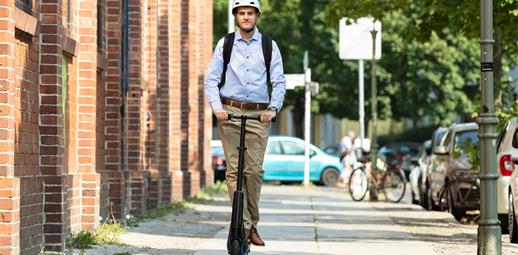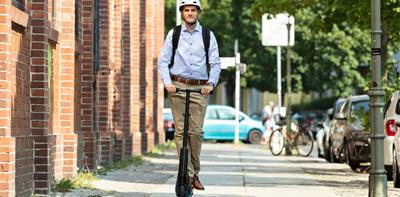
Some people say e-scooters could revolutionise travel and help tackle pollution and congestion.
But others argue they’re a public danger, especially as many people are using them illegally.
Here we explain the debate about e-scooters and look at the arguments for and against their use.
The rules on e-scooters
E-scooters, or electric scooters, are becoming increasingly popular in the UK and beyond. But they’re controversial and there is a lot of confusion about the rules on how they can be used.
Similar to conventional kick scooters, but powered by an electric motor and battery, it’s actually illegal to ride an e-scooter on public roads, cycle lanes or pavements[1]. Despite this, you can still easily buy them in many stores, such as Halfords (although John Lewis has stopped selling them[2]). It’s also becoming increasingly normal to see people riding them on roads and pavements in the UK.
People riding e-scooters on public roads and pavements risk being handed a £300 fine and 6 points on their licence[3]. E-scooter riders jumping a red light, using a mobile phone or riding on the pavement all risk fines and penalty points, according to the Met Police[4].
E-scooters are not illegal in all circumstances though. People are allowed to use them on private land, with the permission of the land-owner, and it is also possible to use a rented e-scooter that is part of a government trial. A number of these are currently underway in towns and cities across the UK[5], while in seaside towns they are popular on the promenades.
The trials, which were rolled out in 2020, have strict conditions. Riders have to hire the scooter from specific companies, they must be over 16 years old and hold at least a provisional driving licence. They can also only use the e-scooters on public roads and cycle lanes, not on pavements, and mustn’t surpass a maximum speed limit of 15.5 mph.
The debate
Supporters of e-scooters argue that they’re legal and allowed on the streets of many countries across Europe and the rest of the world, and the UK should follow suit[6]. But their popularity among the public is very mixed.
Halfords surveyed 2,000 adults and said around two in five were in favour of e-scooters[7].
The e-scooter retailer said its poll suggested that if e-scooters were legal to ride on public roads, one in three adults would consider using them for shorter journeys. A similar proportion of people might swap their car for one.
After all, supporters of e-scooters see them as an alternative to cars as they’re cheaper to run and easier to park.
They have also been hailed as a greener, more sustainable mode of transport that could help to reduce traffic congestion and pollution. It was the green agenda in October 2020 that prompted MPs to recommend that e-scooters should be legalised in the UK within 18 months[8].
However, their environmental benefits have been disputed. Cycling and walking charity Sustrans points to a study in France, in which 4,000 users of public e-scooters were asked how they would have travelled if e-scooters weren’t available. Only 3% of respondents would have used a private car if no e-scooters had been available, while 44% said they would have gone on foot, 30% would have used public transport and 12% would have cycled[9].
But the biggest concern among critics of e-scooters is around safety, and particularly their illegal use on pavements and by children.
Critics say they are often driven dangerously, leading to a number of reported injuries, and even deaths. YouTube star Emily Hartridge became the first e-scooter rider to be killed in the UK in July 2019[10].
In May, a three-year-old child walking on the pavement with his grandmother was hit from behind by a person riding an e-scooter on the footpath[11]. The child was taken to hospital in an ambulance, where he was found to have suffered two broken collarbones.
Such incidents have led to calls for government trials to be halted and reviewed before more people are hurt.
Some organisations highlight the threat to street accessibility caused by e-scooters. The RNIB, the sight loss charity, says e-scooters are extremely difficult for blind or partially sighted people to see and hear and has “serious concerns” about the risk of collisions[12]. It suggests there could be a requirement for e-scooters to make a recognisable sound to alert people one is nearby.
Meanwhile, Sustrans notes that many e-scooter users don’t realise that they’re illegal to use on public roads, and recommends users are made aware of this when they buy their e-scooter. Sustrans’ other recommendations include improving cycling infrastructure that would also protect users of e-scooters.
So, the debate continues. With growing pressure for people to leave their cars at home and finder a greener way to travel, pressure is likely to build on legalising e-scooters, even as concerns remain about the safety issues.
To read more about road safety go to Solved.
[1] https://www.thamesvalley.police.uk/police-forces/thames-valley-police/areas/advice/e-scooters-what-are-the-rules/
[2] https://www.bbc.co.uk/news/technology-55719218
[3] https://www.thamesvalley.police.uk/police-forces/thames-valley-police/areas/advice/e-scooters-what-are-the-rules/
[4] https://www.bbc.co.uk/news/technology-55719218
[5] https://www.gov.uk/guidance/e-scooter-trials-guidance-for-users
[6] https://www.halfords.com/cycling/advice/electric-scooter-petition.html
[7] https://inews.co.uk/news/government-action-e-scooters-halt-uk-roll-out-injuries-1018368
[8] https://news.sky.com/story/e-scooters-should-be-legalised-in-the-next-18-months-to-help-cities-go-green-mps-say-12087116
[9] https://www.sustrans.org.uk/our-blog/policy-positions/all/all/our-position-on-e-scooters
[10] https://news.sky.com/story/youtuber-emily-hartridge-killed-in-uks-first-fatal-electric-scooter-crash-11762673
[11] https://news.met.police.uk/news/appeal-after-child-injured-in-collision-with-e-scooter-in-feltham-426735
[12] https://www.rnib.org.uk/news/campaigning/e-scooter-challenge-streets-safety


